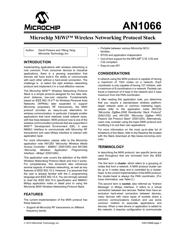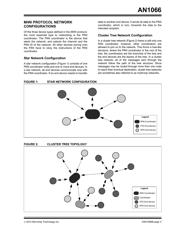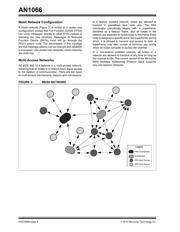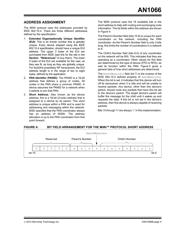Datasheet 搜索 > 8位微控制器 > Microchip(微芯) > PIC16C54C-20/P 数据手册 > PIC16C54C-20/P 开发手册 5/22 页

 器件3D模型
器件3D模型¥ 18.818
PIC16C54C-20/P 开发手册 - Microchip(微芯)
制造商:
Microchip(微芯)
分类:
8位微控制器
封装:
DIP-18
描述:
MICROCHIP PIC16C54C-20/P 微控制器, 8位, 一次性可编程, PIC16C5xx, 20 MHz, 768 Byte, 25 Byte, 18 引脚, DIP
Pictures:
3D模型
符号图
焊盘图
引脚图
产品图
页面导航:
技术参数、封装参数在P18
导航目录
PIC16C54C-20/P数据手册
Page:
of 22 Go
若手册格式错乱,请下载阅览PDF原文件

© 2010 Microchip Technology Inc. DS01066B-page 5
AN1066
ADDRESS ASSIGNMENT
The MiWi protocol uses the addresses provided by
IEEE 802.15.4. There are three different addresses
defined by the specification:
1. Extended Organizationally Unique Identifier
(EUI): This is an 8-byte number that is globally
unique. Every device shipped using the IEEE
802.15.4 specification, should have a unique EUI
address. The upper 3 bytes of the EUI are
purchased from IEEE (see link for the site in the
Section “References” to buy them). The lower
5 bytes of the EUI are available for the user, as
they see fit, as long as they are globally unique.
For SubGHz proprietary RF transceivers, the EUI
address length is in the range of two to eight
bytes, defined by the application.
2. PAN Identifier (PANID): The PANID is a 16-bit
address that defines a group of nodes. All
nodes in the PAN share a common PANID. A
device assumes the PANID for a network when
it selects to join that PAN.
3. Short Address: Also known as the device
address, this is a 16-bit (2-byte) address that is
assigned to a device by its parent. This short
address is unique within a PAN and is used for
addressing and messaging within the network.
IEEE specifies that the PAN coordinator always
has an address of 0000h. The address
allocation is up to the PAN coordinator from that
point forward.
The MiWi protocol uses the 16 available bits in the
short address to help with routing and exchanging node
information. The bit fields within the address are shown
in Figure 4.
The Parent’s Number field (bits 10-8) is unique for each
coordinator on the network, including the PAN
coordinator. As the Parent’s Number field is only 3-bits
long, this limits the number of coordinators in a network
to 8.
The Child’s Number field (bits 6-0) of any coordinator
on the network will be 00h. This indicates that they are
operating as a coordinator. Other values for this field
are determined by the type of device (FFD or RFD), as
well its function within the PAN. Figure 5 gives a
general idea of how short addresses are determined.
The RxOffWhenIdle field (bit 7) is the inverse of the
IEEE 802.15.4 defined property of RxOnWhenIdle.
When this bit is set, it indicates that this device will turn
off its transceiver when it is Idle and will be unable to
receive packets. Any device, other than this device’s
parent, should route any packets that have this bit set
to the device’s parent. The target device’s parent will
buffer the message for the child until it wakes up and
requests the data. If this bit is not set in the device’s
address, then this device is always capable of receiving
packets.
Bits 15 through 11 are always ‘0’ in this implementation.
FIGURE 4: BIT FIELD ARRANGEMENT FOR THE MiWi™ PROTOCOL SHORT ADDRESS
Reserved Parent’s Number Child’s Number
00000xxxxxxxxxxx
RxOffWhenIdle
bit 15 bit 0
器件 Datasheet 文档搜索
AiEMA 数据库涵盖高达 72,405,303 个元件的数据手册,每天更新 5,000 多个 PDF 文件






